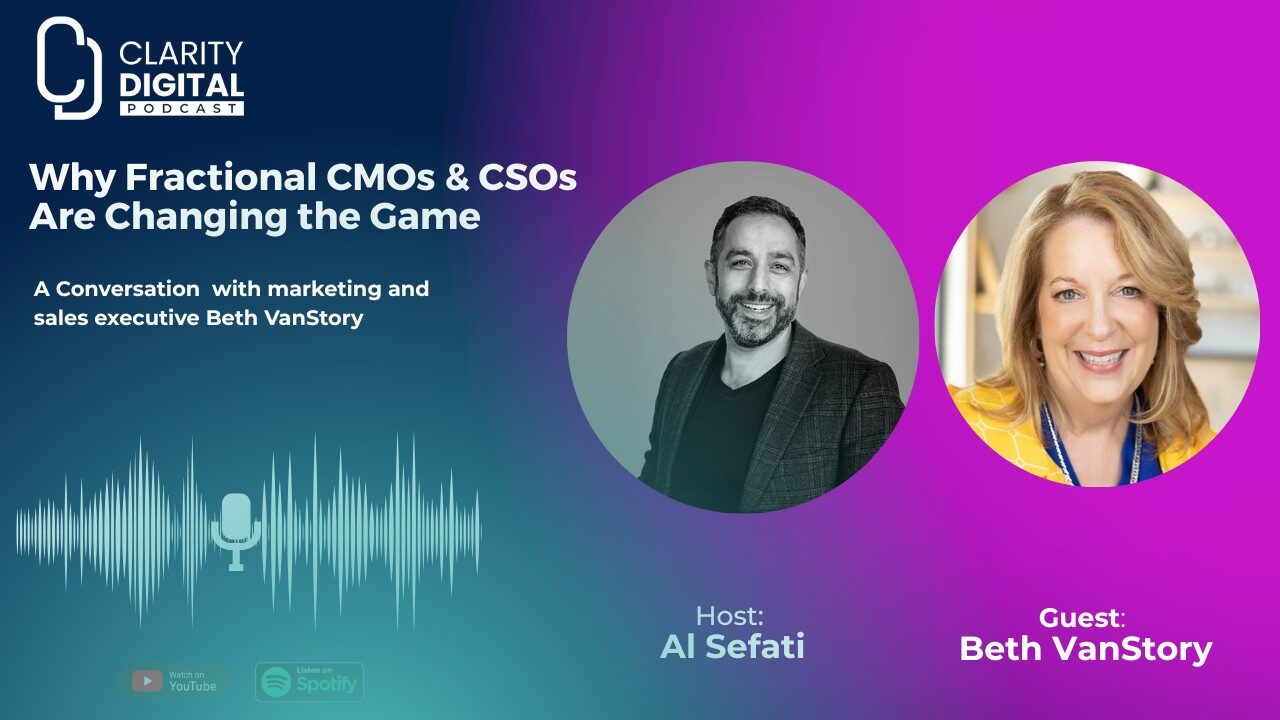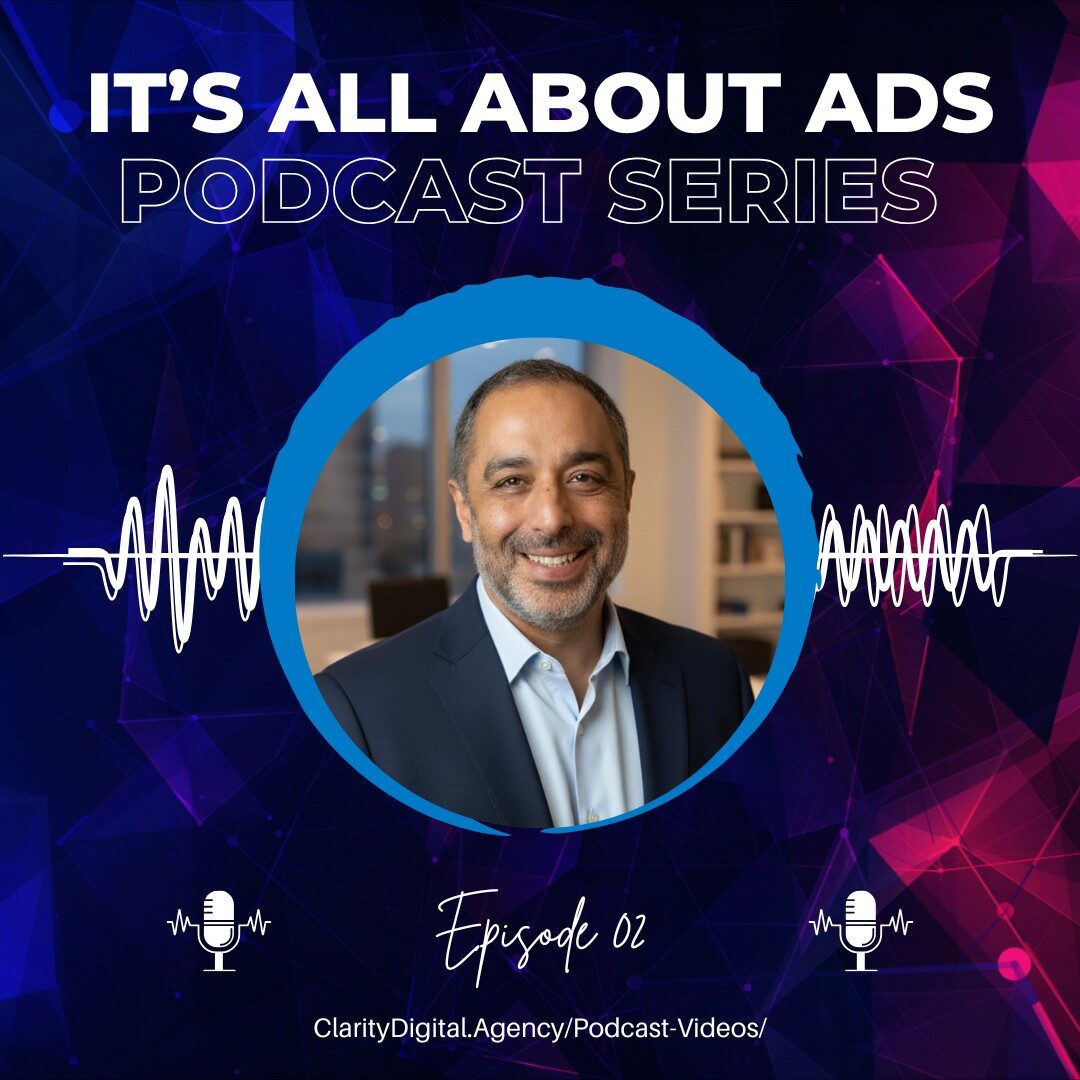with Beth VanStory of Veritech Group
In this episode of the Clarity Digital Pod, I sat down with Beth VanStory, a seasoned marketing strategist and founder of Veritech Group, to dive deep into the evolving world of fractional CMOs and fractional CSOs (Chief Sales Officers). Beth brings decades of experience, from leading new media at The Weather Channel to launching OfficeDepot.com, and more recently, helping mid-market companies build scalable go-to-market strategies.
Over the last few years, there’s been a noticeable shift in how companies are building their marketing and sales leadership. More and more, companies are embracing fractional executive roles—particularly CMOs and CSOs—as a smarter, leaner way to access seasoned talent without the overhead of a full-time hire.
Let’s break down the major takeaways from our conversation.
What Is a Fractional CMO or CSO—and Why Do They Matter?
Beth explains it clearly: companies today often need strategic leadership but may not be in a position to hire a full-time CMO or CSO. That’s where fractional executives come in.
A fractional CMO steps in during gaps—like when a company is between hires, someone is on parental leave, or when a company simply doesn’t need a full-time CMO year-round. The same applies to fractional CSOs or CROs (Chief Revenue Officers), who blend sales and marketing leadership, particularly in B2B or e-commerce sectors.
Companies often turn to fractional leaders when:
- Revenue numbers are flat or declining
- Internal teams lack true strategic leadership
- Marketing feels reactive instead of driven by data and insights
- Sales infrastructure is broken or misaligned
Beth also emphasized a major difference: a lot of folks out there are calling themselves fractional CMOs, but many don’t have the full strategy and leadership background. They may be digital marketers or growth hackers, but not true marketing executives. That confusion muddies the waters and devalues the role.
The Real Job of a CMO: It’s More Than Just Marketing Tactics
We dug into something I’ve seen often in my own agency work: too many companies conflate marketing execution with strategy.
Beth explained how a true CMO—or CSO—brings a strategic lens to the table. It’s not just “let’s do SEO” or “double down on social.” It’s asking:
- Who’s our ideal customer?
- What companies and personas are we targeting?
- What market trends and gaps can we capitalize on?
- How do we message in a way that owns the white space?
This kind of insight drives everything from positioning to channels to budget allocation. As Beth said, “Without this upfront strategic work, you’re executing on a flawed strategy.”
I’ve been in the same position myself—brought in to run digital marketing, only to realize I needed to step into a quasi-fractional CMO role because the person above me didn’t understand the funnel, customer journey, or attribution modeling.
Why Some CMOs Choose the Fractional Path
For seasoned CMOs, going fractional isn’t just about flexibility. It’s about choosing the work that excites them and leveraging their skills across multiple clients.
Beth explained the draw of variety and impact. Fractional work lets her focus on strategy, get in early, build systems, and exit when a company is ready to hire a full-time team to execute. Often, they don’t need a full-time CMO—just someone to set the direction and install the right infrastructure.
It also helps companies avoid the mistake of prematurely hiring a “Head of Marketing” or “Swiss Army knife marketer,” who ends up stretched thin and unable to deliver strategic guidance.
The Overlap Between Sales and Marketing Is Still Murky
Beth and I both agreed that the handoff between marketing and sales is still fuzzy in many companies. There’s often no clean lead qualification or nurturing process. You get MQLs going nowhere or sales reps chasing the wrong leads. And in some cases, there’s simply no sales infrastructure at all—no CRM setup, no tracking, no accountability.
A fractional CSO can step in to fix this. They can build sales processes, set up compensation plans, train reps, and optimize CRMs like Salesforce or HubSpot. Beth emphasized that without the right systems and alignment, marketing won’t convert and sales can’t scale.
And I’ll add—this isn’t just a problem for startups. I’ve worked with enterprise-level companies that are spending big money on tools like HubSpot Enterprise or Salesforce, but using 10% of the functionality because they have no strategy.
The Role of AI in Marketing and Sales: Still Early, But Promising
We couldn’t have this conversation in 2025 without touching on AI. Beth noted that we’re still in the early innings—most companies are using AI for content creation, ad copy, and maybe a few automations. But many are doing it poorly.
She shared how tools like HubSpot’s new AI assistant, Breeze, are starting to enable smarter sales support, like lead scoring and behavioral segmentation. On the marketing side, AI is being used to draft blogs, ads, and images—but the real power lies in data, personalization, and analytics.
Beth made a great point: AI is only as good as the inputs and the human oversight. You still need a human to set the tone, check accuracy, and ensure alignment with brand voice. As she said, “It’s still the Wild West out there.”
When Companies Say “Marketing Isn’t Working”—It’s Time to Call a CMO
Beth shared a smart framework that I’ve experienced myself: when companies say things like…
- “We spent money on SEO/PPC but it didn’t move the needle.”
- “We redesigned our website three times and nothing changed.”
- “Our traffic is up, but leads are flat.”
…that’s the time to bring in a strategic mind. These red flags usually mean there’s either a product-market fit issue, a messaging problem, or a broken go-to-market strategy.
Too often, I’ve been brought in to execute PPC or SEO only to find that the foundation isn’t there. There’s no buyer persona, no competitive research, no roadmap. In those cases, a true CMO can recalibrate the direction before wasting more budget on execution.
Real Research Still Matters—Personas, Voice of Customer, Competitive Insights
Beth gave a solid reminder: most companies think they know their customers, but they don’t ask the right questions—or the right person.
As a market researcher, she often uncovers blind spots by conducting third-party interviews. Customers are more honest with an independent researcher than they are with an in-house marketer.
She shared how surveys (usually via email, sometimes through panel companies) can uncover critical info like:
- Why customers chose them—or didn’t
- Which features of competitors they prefer
- What language resonates in the buying process
She also warned about flawed internal personas that aren’t backed by research. Good research guides content, ads, positioning, and product development. Without it, you’re flying blind.
Aligning With C-Level vs. Execution Teams
One of the nuances Beth explained well is how a good fractional CMO must communicate differently depending on who’s in the room.
To executives (CEO, CFO), the conversation is about top-line metrics—revenue, margin, cost of acquisition, and strategic roadmap.
To internal marketing teams, it’s more tactical—channel performance, lead conversion rates, campaign execution.
A strong CMO can bridge both worlds, present bad news early, and come with solutions—not excuses. As Beth said, “You need to be honest and early. Don’t wait for the execs to ask why.”
That’s a lesson a lot of marketers still struggle with. Metrics must ladder up to business outcomes. Vanity metrics like traffic or impressions don’t fly in the boardroom.
Final Thoughts: The True Value of Fractional Leadership
Beth left us with this insight: the best fractional CMO engagements are not just about ticking off deliverables. It’s about adding value, uncovering new opportunities, and sticking around to see the transformation through.
Sometimes that means acting as the strategic integrator, bringing in specialists like content writers, SEO experts, or creative teams. Sometimes it means sitting with the leadership team and shaping broader go-to-market plans, even finance modeling.
Her firm, Veritech Group, focuses on companies doing $10M+ in revenue—often ones that are stuck, scaling, or in transition. And she’s crystal clear about who she helps and how.
I’ll say this—if you’re a growing company and you’ve hit a wall with your marketing, it might not be your SEO or ads. It might be that you’re missing a strategic mind at the table.
Where to Find Beth VanStory
Beth is Managing Partner at Veritech Group. You can reach her directly at [email protected]. Veritech works with mid-market companies on strategy, sales, and marketing execution—with a heavy focus on getting things done right from day one.
Are you a CMO, CSO or a seniormarketing leader looking to collaborate with Clarity Digital on strategy or share your insights on our podcast? Reach out here. We’d love to connect.




